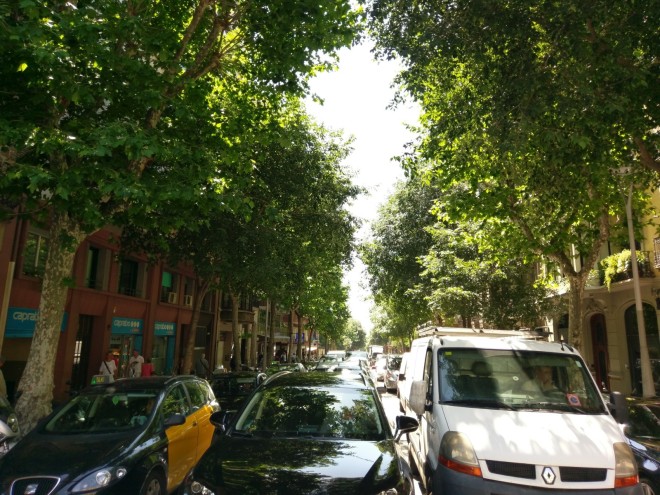I just got back from a little holiday that took me to Barcelona.
In Barcelona I was thrilled to stay in the famous Eixample district. In the kind of urbanism blogs I like to to read, Eixample has been used so often as an example of density done right, that I was pretty stoked to get a taste of the life it has to offer.
Eixample is famous for its donuts. Not the bready treat, but the shape of its blocks. (Spanish calls them manzanas, or apples, but I call them donuts.) They are octagonal blocks exactly 133m in length.

The six to eight storey buildings of this “newer” part of Barcelona are often held out as a counterpoint to the fifty storey needles I can see piercing the sky above Melbourne. So I had high expectations of the experience I would get when I booked my airbnb in the heart of the region. It was amazing, as I expected. But my high expectations meant I came away with a few reservations.
First, the good stuff: there is lots of ground level retail, lots of restaurants etc, and lots of apartments above them, all arranged in a distinctive urban form. Public transport is abundant. The place is buzzing day and night, which means you want a quiet apartment facing the interior of the block.

And it was the hollow interiors of the blocks of Eixample that were the site of my first disappointment. The cores are all built over.
Our apartment had a balcony facing the interior of the donut. It was nice and quiet, but rather than a green space below, we looked down on a bunch of roofs. The ground floor retail has been so successful they have basically all built out to the very back of their blocks, leaving very little open space inside the donut at ground level.

There are one or two exceptions to this rule in the Eixample district – I saw one tunnel leading through to a children’s playground. But Google Maps shows the interiors of the octagons mostly all built over.
The problem is compounded by the near total absence of open space in the district. Regular readers of this blog will know that I am no knee-jerk admirer of open space. But just as I think Melbourne can sometimes go too far in one direction, Barcelona goes too far in the other.
All those blocks, and none left open as a Plaça? Nowhere to sit and take your espresso without traffic whizzing by? The lessons of old Europe were not applied!
This becomes all the sadder when you look at the original plan for Eixample. (Eixample, which I found out is not pronounced remotely like the word example, means expansion. It was designed as a contrast to the higgledy piggledy old town of Barcelona.) The original plan shows not only were plaças dotted around, but the octagonal blocks were intended to be developed on only two or three sides.

Developer interests have been making a mockery of density intentions for a long time.
One thing that has been preserved from the above map is the octagonal blocks. In contrast to the square corners of grids like Manhattan’s or Melbourne’s these mean the intersections have an open feel. Sounds great, right? And it is great, for drivers.
That open space is mostly devoted to road.

They use some of the extra space for parking, some for huge dumpsters and some to make the footpaths slightly wider, but cars can still zoom around the corners. It reminded me of the lesson of the “sneckdown” – a lot of road space is often allocated to cars that they don’t necessarily need. You can actually see a colour differential on the road above where traffic rarely treads. That space could be better used.
The following picture shows a fairly typical scene at an Eixample intersection – crowded with vehicles.

The octagonal design also means pedestrian crossings are shifted back up the street. To cross the road, pedestrians must divert from the shortest distance between two points.

The blocks are reasonably short, so if you’re walking a long way, that’s a lot of meandering. Some people don’t bother diverting to take the lights, and just wander out across the expanse of road instead. The pedestrian crossing placements mean the two at each corner are not adjacent, so if you just miss one light, you have to walk back across the chamfered corner to get to the other one. A small pain point, to be sure, but a real one when it is repeated so often.
In summary, the Eixample district charmed me, but was somewhat more car-focused than I’d expected.


Eixample is an expensive and desirable part of Barcelona. You can get some pretty fancy smashed avocado there, which says a lot. The part of the old town called El Raval, meanwhile, remains amazingly rough and ready.
So, Eixample was very easy and enjoyable to live in, but not quite the urban design paradise I’d imagined. And in fact, some of the problems I’ve mentioned are currently being reviewed.
- Barcelona has a new green space plan to make more space and green it.
- It is also introducing “superblocks” where cars are banned from certain city streets. That is not going very easily, which is to be expected!
Have you been to Eixample? Any thoughts on its advantages and disadvantages? Leave a comment below!